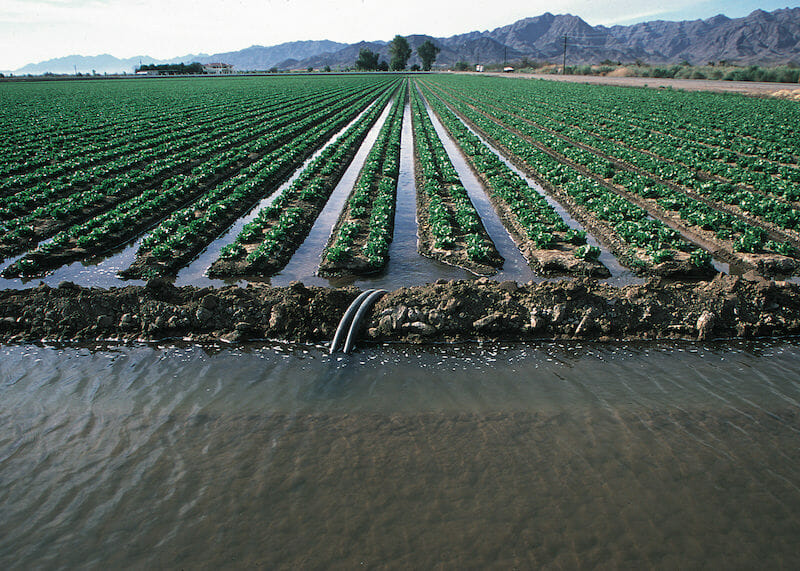Trump’s FDA Won’t Make Lettuce Farms Test for Deadly Bacteria
Congress ordered a fix to a gaping hole in food safety years ago, but the administration postponed a remedy that could prevent outbreaks. At least 216 people became sick after an outbreak of the pathogen E. coli contaminated romaine lettuce grown in Yuma, Ariz. (Jeff Vanuga)
At least 216 people became sick after an outbreak of the pathogen E. coli contaminated romaine lettuce grown in Yuma, Ariz. (Jeff Vanuga)
William Whitt suffered violent diarrhea for days. But once he began vomiting blood, he knew it was time to rush to the hospital. His body swelled up so much that his wife thought he looked like the Michelin Man, and on the inside, his intestines were inflamed and bleeding.
For four days last spring, doctors struggled to control the infection that was ravaging Whitt, a father of three in western Idaho. The pain was excruciating, even though he was given opioid painkillers intravenously every 10 minutes for days.
His family feared they would lose him.
“I was terrified. I wouldn’t leave the hospital because I wasn’t sure he was still going to be there when I got back,” said Whitt’s wife, Melinda.
Whitt and his family were baffled: How could a healthy 37-year-old suddenly get so sick? While he was fighting for his life, the U.S. Centers for Disease Control and Prevention quizzed Whitt, seeking information about what had sickened him.
Finally, the agency’s second call offered a clue: “They kept drilling me about salad,” Whitt recalled. Before he fell ill, he had eaten two salads from a pizza shop.
The culprit turned out to be E. coli, a powerful pathogen that had contaminated romaine lettuce grown in Yuma, Arizona, and distributed nationwide. At least 210 people in 36 states were sickened. Five died and 27 suffered kidney failure. The same strain of E. coli that sickened them was detected in a Yuma canal used to irrigate some crops.
For more than a decade, it’s been clear that there’s a gaping hole in American food safety: Growers aren’t required to test their irrigation water for pathogens such as E. coli. As a result, contaminated water can end up on fruits and vegetables.
After several high-profile disease outbreaks linked to food, Congress in 2011 ordered a fix, and produce growers this year would have begun testing their water under rules crafted by the Obama administration’s Food and Drug Administration.
But six months before people were sickened by the contaminated romaine, President Donald Trump’s FDA – responding to pressure from the farm industry and Trump’s order to eliminate regulations – shelved the water-testing rules for at least four years.
Despite this deadly outbreak, the FDA has shown no sign of reconsidering its plan to postpone the rules. The agency also is considering major changes, such as allowing some produce growers to test less frequently or find alternatives to water testing to ensure the safety of their crops.
The FDA’s lack of urgency dumbfounds food safety scientists.
“Mystifying, isn’t it?” said Trevor Suslow, a food safety expert at the University of California, Davis. “If the risk factor associated with agricultural water use is that closely tied to contamination and outbreaks, there needs to be something now. … I can’t think of a reason to justify waiting four to six to eight years to get started.”
The deadly Yuma outbreak underscores that irrigation water is a prime source of foodborne illnesses. In some cases, the feces of livestock or wild animals flow into a creek. Then the tainted water seeps into wells or is sprayed onto produce, which is then harvested, processed and sold at stores and restaurants. Salad greens are particularly vulnerable because they often are eaten raw and can harbor bacteria when torn.
After an E. coli outbreak killed three people who ate spinach grown in California’s Salinas Valley in 2006, most California and Arizona growers of leafy greens signed agreements to voluntarily test their irrigation water.
Whitt’s lettuce would have been covered by those agreements. But his story illustrates the limits of a voluntary safety program and how lethal E. coli can be even when precautions are taken by farms and processors.
Farm groups contend that water testing is too expensive and should not apply to produce such as apples or onions, which are less likely to carry pathogens.
“I think the whole thing is an overblown attempt to exert government power over us,” said Bob Allen, a Washington state apple farmer.
While postponing the water-testing rules would save growers $12 million per year, it also would cost consumers $108 million per year in medical expenses, according to an FDA analysis.
For Whitt and his family, his illness has been traumatic as well as costly. After returning home from his nine-day hospital stay, he relied on narcotic painkillers for about six weeks. The infection caused a hernia and tore holes in the lining of his stomach that surgeons had to patch with mesh. Five months later, he still has numbness from the surgery and diarrhea every week.
Whitt and his wife said it is irresponsible for the FDA to postpone the water-testing requirements when officials knew that people like Whitt could pay a hefty price.
“People should be able to know that the food they’re buying is not going to harm them and their loved ones,” Melinda Whitt said. “At this point, we question everything that goes into our mouths.”
FDA Shows No Urgency
The federal government often requires water testing to protect the public: Tap water is tested to make sure it meets health standards, and so are beaches, lakes and swimming pools.
But under the Trump administration plan, large growers wouldn’t have to start inspecting their water systems and annually test surface waters for pathogens until 2022.
Then they will have an additional two years to ensure irrigation water that comes in contact with vegetables and fruit does not contain E. coli above a certain concentration.
For the smallest farms, inspections and annual testing will begin in 2024, and they will have until 2026 to meet E. coli standards.
That means full compliance with the safeguards wouldn’t come until 20 years after three people died from eating California spinach, 15 years after Congress signed the Food Safety Modernization Act and eight years after Whitt and more than 200 others were sickened by romaine lettuce.
While the delay is just a proposal for now, the FDA has assured growers that it will not enforce the requirements in the meantime.
FDA officials declined interview requests. But a spokeswoman said the agency proposed the delay to ensure the testing requirements are effective.
“The Yuma outbreak does indeed emphasize the urgency of putting agricultural water standards in place, but it is important that they be the right standards, ones that both meet our public health mission and are feasible for growers to meet,” FDA spokeswoman Juli Putnam said in response to written questions.
In addition, the FDA did not sample water in a Yuma irrigation canal until seven weeks after the area’s lettuce was identified as the cause of last spring’s outbreak. And university scientists trying to learn from the outbreak say farmers have not shared water data with them as they try to figure out how it occurred and avoid future ones.
Why Farmers Should Test Water
The FDA has yet to unravel the mystery of how the Yuma romaine sickened so many people. But irrigation water is a “viable explanation,” the FDA said in an August update. Analysis of water samples from canals detected E. coli with the same genetic fingerprint as the bacteria that sickened Whitt and others. A large cattle feedlot is under investigation as a possible source.
The romaine outbreak is reminiscent of the 2006 spinach outbreak, which sickened at least 200 people in 26 states, killing a 2-year-old boy and two elderly women. Inspectors traced the E. coli strain to a stream contaminated with feces from cattle and wild pigs that then seeped into well water.
Many growers irrigate with water straight from streams or wells without testing it for pathogens. Pathogens from water can be absorbed by a plant’s roots. A CDC review reported that almost half of all foodborne illnesses from 1998 to 2008 were caused by produce.
Scientists from Rutgers, The State University of New Jersey, found in 2014 that investigations of tainted produce “often implicate agricultural water as a source of contamination.” Another study by FDA researchers in May noted that salmonella in irrigation water “has been regarded as one of the major sources for fresh produce contamination, and this has become a public health concern.”
In the wake of the public outcry over the spinach outbreak, California and Arizona suppliers of salad greens created their own voluntary safety program in 2007. Since then, water testing has become commonplace in the Salinas Valley, known as the nation’s “salad bowl” because about 60 percent of all leafy greens are grown there.
On one recent foggy summer morning, Gary and Kara Waugaman stood in the fields of a ranch near the Salinas Valley town of Watsonville. The Waugamans are food safety coordinators for Lakeside Organic Gardens, a vegetable grower and shipper. Clad in neon vests and jeans, they drove from field to field, examining soil, surveying plants and testing water.
“We got red chard, green chard, rainbow chard, green kale, red kale, lacinato and then collards,” Gary Waugaman said, pointing at row after row of colorful leafy plants.
Kara Waugaman stepped onto an open, concrete-lined reservoir. A single duck floated on the surface. It appeared clean, “but you can’t tell anything by looking,” she warned.
In her years of testing water from this underground well, she never has found a sample with fecal contamination high enough to violate industry standards. Using a special stick, she dipped a small glass bottle into the reservoir; it disappeared with a tiny glug, then emerged full of clear water.
Next, the Waugamans drove to another farm. Baby Brussels sprouts poked out of leafy plants. A powerful rotating sprinkler showered Kara Waugaman as she ran toward it and quickly filled a small bottle.
For about 10 years, the Waugamans have sent samples to a laboratory that tests for generic E. coli. If a certain concentration of what is known as “indicator” bacteria is detected, it could be a sign of more dangerous pathogens like the one that sickened Whitt.
The two farms the Waugamans visited that day participate in the voluntary California Leafy Greens Marketing Agreement. Members test agricultural water once a month and submit to audits by state inspectors.
Mike Villaneva, the agreement’s technical director, said he hopes growers elsewhere soon will get on board with water testing.
“Our feeling is that everyone ought to know their water quality, and the only way you know that is by testing,” he said.
But if the Yuma farms were voluntarily testing their water for pathogens, how did E. coli contaminate the lettuce? There may never be an answer.
“Everyone is in shock because the (growers) really felt their (voluntary) program would prevent not every and all sporadic illnesses, but a large outbreak like this,” Suslow said. “They’re reeling with that failure and working to figure out what to do to prevent it from taking place again.”
He hopes this failure will persuade them to give researchers access to water data collected before the romaine outbreak and in the future.
Villaneva and Gary Waugaman said the monthly testing is not foolproof; it minimizes, but doesn’t eliminate, the risks. Also, pathogens from livestock and other animals can get into crops from wind, dust and other means.
The contaminated lettuce likely came from multiple farms. But the only grower named so far, Harrison Farms, is a member of the Arizona alliance that agreed to follow the voluntary safety measures, including water testing.
Harrison Farms said in a statement that it has tested its irrigation water on a monthly basis for the past 10 years and that it met federal standards for E. coli during the last growing season. The farm said its fields and water supply “underwent a thorough investigation” by the FDA in May that “did not yield any significant findings.”
Although the federal rules may not have prevented the Yuma outbreak, experts say they could help prevent the next one. The requirements would have been mandatory nationwide and applied to all produce.
But Patty Lovera of Food & Water Watch, a Washington, D.C.-based group that advocates for safe food and water, called the Obama-era rules “unmanageable.” She said produce contaminated by tainted water is unacceptable, but so is shutting down small farms that can’t afford the testing.
“It’s a terrible situation,” she said. “The (federal rule) solution could have a lot of casualties. That’s not acceptable either.”
Stuart Reitz thinks onion growers shouldn’t have to test water at all.
“We haven’t seen any evidence that there’s contamination of onions from any pathogenic bacteria in irrigation water,” said Reitz, a scientific adviser to the Malheur County Onion Growers Association in Oregon.
Allen, the Washington apple farmer, estimates that it would cost him about $5,000 for the first two years of testing his irrigation water. He thinks it’s a waste of time and money because no outbreaks have been tied to the state’s apples.
“I’m not gonna test,” he said. “If they want to throw me in jail, well then, OK, guess I have to go to jail.”
FDA to Growers: ‘Keep Doing What You’re Doing’
The FDA’s deference to growers was on full display at a February meeting, two months before the romaine outbreak made national headlines.
During a two-day recorded workshop with growers and other industry officials, Stephen Ostroff, the FDA’s deputy commissioner for foods and veterinary medicine, told growers that federal scientists had investigated “far too many produce-related outbreaks over the years where water turned out to be the culprit. There is no question that to reduce the risk of contamination of produce by the water that’s used on the crops, we need water standards.”
But Ostroff reassured the audience members that the FDA wants their feedback to develop new “requirements that are less burdensome while protecting public health.”
“We see revisiting the water standards as a collaboration with stakeholders, including all of the stakeholders in this room,” he said.
“All options are on the table, including reopening the rule,” he told them.
The safety requirements would not be implemented anytime soon, FDA officials told the group.
“Rather than kind of rushing to make a set decision, (we’re) just focusing on, you know, working with you guys for now,” said FDA staff fellow Chelsea Davidson.
James Gorny, a former industry lobbyist whom the FDA hired in February to implement produce safety rules, told the group that the agency would not ask anything of growers in the interim.
“The FDA has clearly stated, ‘Keep doing what you’re doing.’ We’re not asking you to do any more at this point in time,” he said.
Gorny’s career is a classic example of the revolving door between federal agencies and the industries they regulate.
In 2006 and 2007, Gorny was a registered lobbyist for the United Fresh Produce Association. Then he worked for the FDA as a food safety scientist for several years. In 2013, he became a vice president of another growers group, the Produce Marketing Association, which has spent $120,000 on lobbying so far this year, according to the Center for Responsive Politics, a campaign finance watchdog group.
Gorny’s hiring by the FDA mirrors a pattern across public health and environmental agencies. The Trump administration has appointed dozens of former industry officials and lobbyists to relax regulations designed to protect public health.
Whitt is suing the restaurant in Nampa, Idaho, that sold him the contaminated salads, and his anger flares when he talks about the FDA delay, as well as all the growers, shippers and processors that played a role in the outbreak and haven’t been identified yet.
“I think everybody is at fault,” Whitt said.
Now his family doesn’t trust the nation’s food supply.
“I’m terrified to eat vegetables,” Whitt said. “I won’t eat them unless they’re cooked. We won’t eat salads. I personally think it’s a broken system right now.”
![]()
Independent journalism is under threat and overshadowed by heavily funded mainstream media.
You can help level the playing field. Become a member.
Your tax-deductible contribution keeps us digging beneath the headlines to give you thought-provoking, investigative reporting and analysis that unearths what's really happening- without compromise.
Give today to support our courageous, independent journalists.








You need to be a supporter to comment.
There are currently no responses to this article.
Be the first to respond.